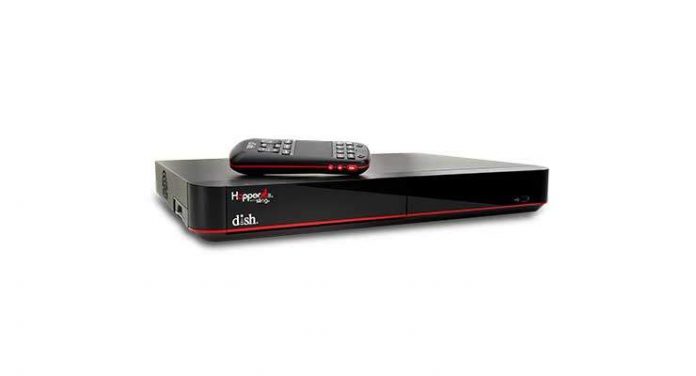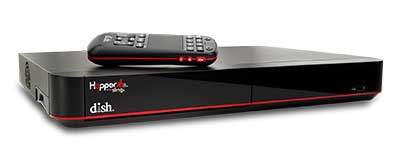
My Super-Sweet 16
Pay TV has long been perceived as a service industry, notable for the channels provided rather than the hardware that enables it. I came of age in the Seventies/Eighties and recall the enormous wired remote control brick (with simulated wood grain, if memory serves) that handled the sudden influx of new channels that cable TV brought. A little lever toggled through three separate tiers, a clunky, analog solution at the front lines of a technological revolution.
Flash forward a few decades and we have satellite delivery as a viable alternative to cable. I’ve been a DISH customer exclusively since 2008, and I’ve attended with great interest their Press Day events at the International Consumer Electronics Show in Las Vegas, where the company’s hardware innovations are every bit as headline-worthy as any of their new service options. In 2016, I received an earful about the new DISH Hopper 3, their newest combination receiver and DVR, and now that I’ve had the opportunity to test drive it for a while here at Rancho Chiarella, I thought I’d share some observations and opinions.
16 Tuners? REALLY?
Really.
The Hopper 3 box is a sleek black affair with a snazzy red stripe, a fine addition to my home theater stack. It arrives with a two-terabyte internal hard drive, which holds about 500 hours of HD programming (we can select either 720p or 1080i) or 2,000 hours SD. And yes, there are 16 individual tuners inside the Hopper 3, which can all be active at once, all recording HD. But get this: If we dedicate one of the tuners to the PrimeTime Anytime feature, we’re essentially using one tuner to record four channels (up to three hours each, the peak-hours programming block for ABC, CBS, NBC and Fox), bumping the effective total up to 19 different feeds being captured! That’s a sure-fire recipe for marital bliss if ever I heard one, as I remember all too well the altercations with my wife for priority over our first-generation ReplayTV, particularly during sweeps weeks. (There were no winners.) Sixteen tuners is all about liberty, and I can happily report that even with the entire brood pitching in to help evaluate, we have never even come close to maxing them out.
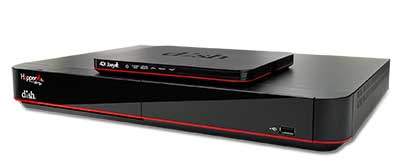
Up on the roof, the Hopper 3 required an updated hybrid LNBF (the antenna or “dish”) to do its new-and-improved thing. As far as I could tell, it was a pretty straightforward swap, performed by my friendly, extremely helpful DISH guy as part of the installation one afternoon. The box also connects wired or wirelessly to our internet service to enable full functionality. The new Hopper 3 was an upgrade from my second-generation Hopper DVR receiver, which in turn had replaced my original workhorse ViP 722 DVR.
It arrived with a pair of Wireless Joey devices, requested in addition to the Hopper. Wireless Joeys are the little pods that extend programming to additional TVs throughout the home. For those whore prefer a corded solution, second-generation Joeys can be wired into Hopper 3 base. Joeys stream recorded content from the Hopper 3 to other rooms, while also providing full access to live channels. With careful positioning, my Joeys were able to function off of the Hopper 3 in my home theater, one Joey upstairs and the other in the basement, despite some stubborn concrete foundation and steel infrastructure in the path of the wireless signal. Up to six Joeys can be run throughout a home setup from a single Hopper 3.
All This, and Netflix Too
DISH was the first major U.S. pay TV provider to add Netflix to a set-top box, and as with the Hopper 2, Netflix is nestled among the premium channels of the Hopper 3, specifically at #370. If you make it that high into the guide and still can’t find any live program to your liking, click to launch Netflix, sign in and start streaming. (Netflix subscription fees apply, naturally.) I prefer this setup versus, say, Netflix built into a Smart TV, since the Hopper 3 is hooked up to my A/V receiver as a source component, giving me surround sound and all of the requisite audio benefits. Netflixing from the TV either limits us to the TV’s built-in audio or requires us to wire audio out of the TV, to the receiver. Any Joeys need to be activated separately with our account information, as additional devices.
4K streaming for Netflix Premium subscribers is supported as well. With more folks going Ultra HD with their home theater setups, DISH does indeed support 4K, for select Video-on-Demand offerings. No, it isn’t live 4K yet, but the good news is that any rented 4K video files are downloaded to the receiver and stored locally for viewing, so there are no buffering issues as with typical streaming. While I was not able to test this feature, it sounds like yet another viable alternative to enjoy those new Ultra HD TVs.
To further sweeten the deal, select programming packages (“America’s Top 200” and above) include 72 channels of Sirius satellite radio, starting at Channel 99 in the guide. I have Classic Rewind playing in the next room—through the home theater speakers with the TV powered off— as I write this. Classic Vinyl is playing the live version of Steely Dan’s “Bodhisattva”! This’ll be awesome the next time we have company, too.
Getting to Know DISH, All Over Again
As ever, the main points of contact are the remote control and the on-screen user interface. Both have undergone a pretty significant evolution from year to year, 2016 included. DISH seems be alternating between more traditional, full-sized remotes reminiscent of the peanut-shaped units of yore and a more streamlined little slab that to me at least has a passing resemblance to a cellphone. The latter is paired with the Hopper 3, shedding a few buttons from last year and offering a new layout that requires a bit of user adjustment. Some features have been enhanced, such as the Recall button which can now bring us back to any of the last six channels visited. The biggest challenge for me are the edge-mounted input/mode keys along the top left side which, if you have a tendency to grab the remote as I do, can be pushed accidentally. It’s a universal remote, so we run the risk of inadvertently switching to a different device when pushing one of those edge buttons. The good news however is that I seldom need my original TV remote anymore, and even master volume control for my Onkyo receiver is now mapped onto the DISH remote.
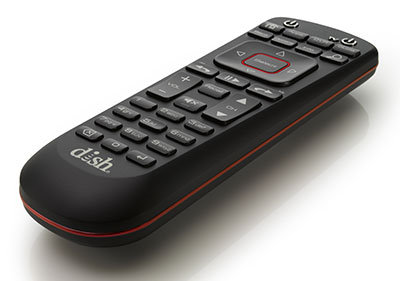
This remote is quite light and it has a lot of little multifunction tricks, some of which are illustrated and pushed to the TV as a sort of screen saver in that moment when the Hopper is powered off but not the television. For instance, we’re informed with text and a simple graphic that the 10-second back/30-second forward skip buttons double as continuous scanning buttons if we press and hold. Or, when we’re viewing the TV schedule grid, these same buttons will also take us forward/back 2.5 hours (one page) or 24 hours with either a tap or a press-and-hold, respectively. A brochure left behind after the installation has an article entitled “15 Tips You’ll Love,” worth reading. We can also press and hold the “Info” button to access relevant help on any screen.
UPDATE: DISH has just recently introduced an optional Voice Remote ($30) to work with the Hopper 3. At first glance it is slightly more squat and a different layout with even fewer raised buttons. There are three main changes:
- Speech recognition is now enabled for voice command, and it delivers search results ranging from channel names, movie or TV show titles, stars, genres or even categories that cross-reference some of these criteria. Not sure if a search term will work? Just try it, there’s nothing to lose.
- At the center of the Voice Remote is now a clickable multifunction touchpad that responds to swipe and scroll gestures as on a laptop.
- The Voice Remote is also illuminated, always a blessing when watching TV in a properly darkened room.
Three new buttons adorn the right edge of the remote: Press and hold the top one with the microphone icon before speaking voice commands, tap the bottom one to illuminate the remote buttons (pressing the “123” button on the remote illuminates the numeric keys in the touchpad, and the edge button in between these two can be programed for a custom command.
Onscreen, the layout of the remarkably deep DISH interface has been redesigned both in terms of style and functionality, tweaked really from 2015 more than reinvented. Higher-level functions are laid out in a series of tabs: Menu, with all of the basics including Settings and Apps; Home, which is more focused on what we might like to watch right now; Shows, which includes cool categories like Series and Season Premieres plus Finales; Sports and finally Movies, which even highlights Free offerings and theatrical releases, with an invitation to play the trailer or even tag them for eventual recording. Here again, there’s enough new and different that it takes some getting used to, if you’re a DISH veteran. Then again, it’s more customizable than ever, right down to the font size, if you’re willing to invest the time. Hint: Get to know the “Options” button.
What was another revelation to me is how proactive the smarts of the Hopper 3 are, even when I am not gainfully searching for anything. When I began this story, I was aggressively working my way through Season Two of Better Call Saul on AMC. No problems recording the show or locating it on the DVR page, but for any episodes not currently stored, it displayed my On Demand options to help me catch up with the fewest number of clicks necessary. Seemingly every channel has its own On Demand service offered for subscribers these days, and all are built right into the Hopper 3. There are no user names, account numbers or passwords to fiddle with: If a channel with an included streaming service is a part of our monthly package, we’re ready to go, although these shows and movies are delivered via the internet rather than satellite. The elegance here is extraordinary.
When we do want to take the initiative and hunt for a particular title (or actor, etc.), any matches within Netflix’s library are now integrated into the universal search results. So when we inquire about an old favorite or something new, we are presented with a master list assembled across Netflix, the recordings currently stored on the DVR, appropriate On Demand choices plus upcoming airings. If it is watchable, one way or another, we can find it.
TV Watching: My Favorite Sport
With literally hundreds of different channels at our disposal, media-hungry viewers might not be satisfied to watch one at a time. A novel twist on traditional picture-in-picture, Sports Bar Mode is reminiscent of the abundant televisions we might find stacked at a testosterone-infused watering hole, ensuring that nary a game is overlooked. Of course this new feature is not relegated to athletic contests so it will work with any channel, showing four at once, two across and two high. If you happen to own a 4K TV, which has the equivalent specs

of four HDTVs—double the horizontal (3,840 pixels wide) and vertical (2,160 lines) resolution—you can actually enjoy all four feeds in true high definition. On a 1080p TV, each quadrant displays at 540p.
We need to delve into the menus to find Sport Bar Mode, a.k.a. “MultiView,” in the Picture-in-Picture settings of Options sub-menu, but then it appears immediately, automatically populating with our most recently viewed channel and three more. Audio is provided for whichever of the four windows is highlighted in red, and this favored feed is selectable via the directional arrows on the remote. I could also adjust that window’s volume up/down and change that channel without affecting the other three. Surprisingly, when I switched to any of the four different feeds, I was able to back-skip, up until the point in time that they first appeared in the Sports Bar Mode configuration. I definitely see the appeal for the sports-minded here, but folks like me might reap the benefit for news coverage instead, such as the upcoming election.
You Can Take It with You
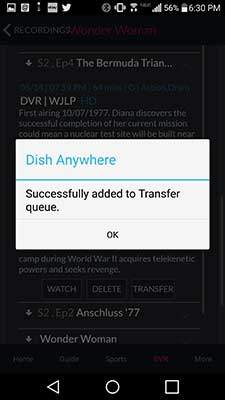
DISH Anywhere remains standard-issue for all subscribers, a robust entertainment app that enables us to watch—and pause—live or recorded TV on a compatible device (assuming an equally robust internet connection), or use a smartphone or tablet as a fancy touchscreen remote control, manage upcoming recordings, and more. We can also transfer recordings to a mobile device running the DISH Anywhere app, space permitting, but be warned that doing so might delete them from the Hopper 3, at the programmer’s discretion. Unlike DISH’s first-generation Hopper, this unit does not require a separate Sling adapter accessory to perform such online place-shifting feats.
There’s no Netflix or Sirius accessible on the app but locals are included and we can also watch On Demand remotely. I think about the tough road that Aereo encountered in their efforts to give viewers similar freedom and can’t help but be impressed by what the DISH Anywhere app makes possible.
GO DISH GO
Also teased at CES was a new piece of hardware, the HopperGO. On sale now for $99, this optional accessory holds up to 100 hours of recorded video within its 64GB flash memory core. It goes beyond the DISH Anywhere app to provide even more reliable out-of-home viewing, particularly valuable at such times when the internet is not readily accessible, or there isn’t much free space on your phone or tablet for offline viewing, or if you want to share with multiple users, up to five at once . The compact, extremely rugged square is at once slightly shorter and wider than a credit card, eminently palmable and pocketable. It is controlled by the DISH Anywhere app, even it’s when plugged into the Hopper 3 via the receiver’s handy front-panel USB port.
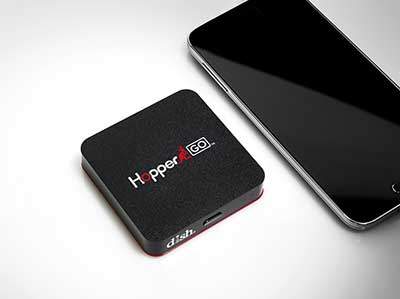
It’s engineered to work wirelessly, generating its own Wi-Fi signal that shows up on our compatible phone or tablet as a new network, then streaming directly between the two. Default network name and password are printed on the bottom of the device, and once the HopperGO is paired to a mobile device, and plugged into the Hopper 3, we’re given the option under the “Transfers” section of the app to move our DVR recordings to the new HopperGO. Some—but not all—recordings come with an announcement that they will be deleted from the DVR after the transfer to HopperGO. So the Hopper 3 a filling station too, and it also compresses the video files for optimized viewing on mobile screens. From there, everything worked exactly as promised. I could see this being quite useful on a plane trip, with a few hours of DVR’d TV episodes tucked neatly in my pocket, and my phone connected to the HopperGO rather than to pricey in-flight Wi-Fi. Note that neither On Demand nor Pay-Per-View content can be transferred to the HopperGO.
Ever-curious, I plugged the HopperGO into my LG V10 Android phone with the included cable to see if this would function as a non-Wi-Fi alternative to watch my outboard-stored content, and it did, perfectly. Although this approach might work with other Android devices too, DISH recommends the wireless network to watch recordings, for the best overall experience. Interestingly, the HopperGO’s internal “up to 4 hour” battery began surrendering its juice to my phone when connected via USB like an external power bank, which would clearly shorten my potential viewing time, so I take their point.
As a rather refreshing non-DISH-centric bonus, we can plug the HopperGO into the computer and load our own media files. Just under 6GB has been pre-partitioned for this purpose, so we can see personal photos and such when not catching up on recorded movies and shows. The way the onboard storage has been laid out, it will protect our personal files even if all HopperGO content is erased. Our own content such as pictures and videos can be backed up from the mobile device to this portable 6GB folder as well.
In Conclusion
The evolution here is apparently ongoing. YouTube integration for example has also been announced for the Hopper 3, coming soon, for an entirely new source of content accessible via the same magic box. Perhaps more than any other TV service provider, DISH really seems to understand the relationship between the programming, the software and the hardware. With the Hopper 3 at the center of a personal entertainment universe, and extending far beyond the home with a cutting-edge app and accessories, DISH is empowering us with an unprecedented joy of TV watching like no one else can.
Be the first to leave a review.


